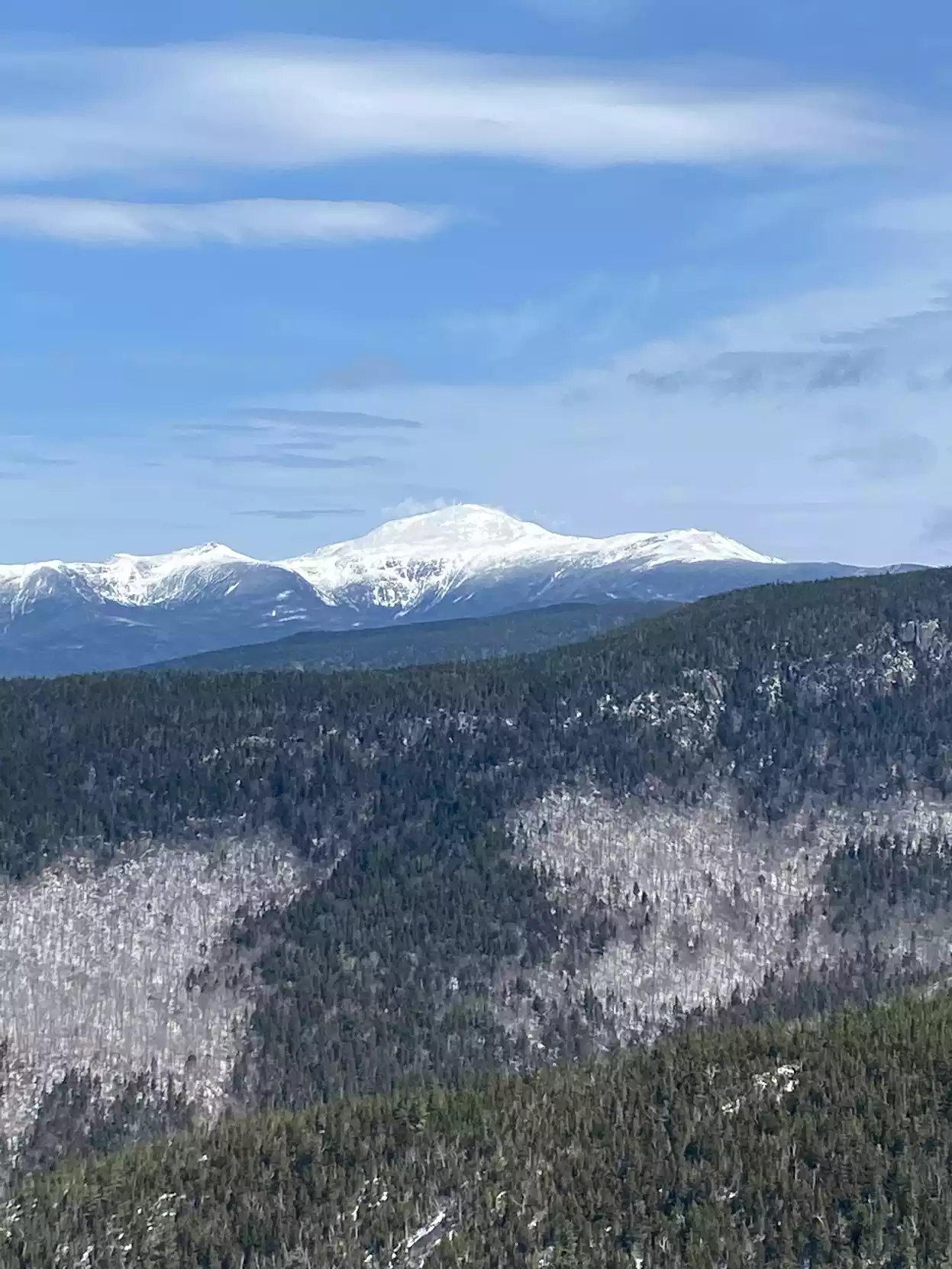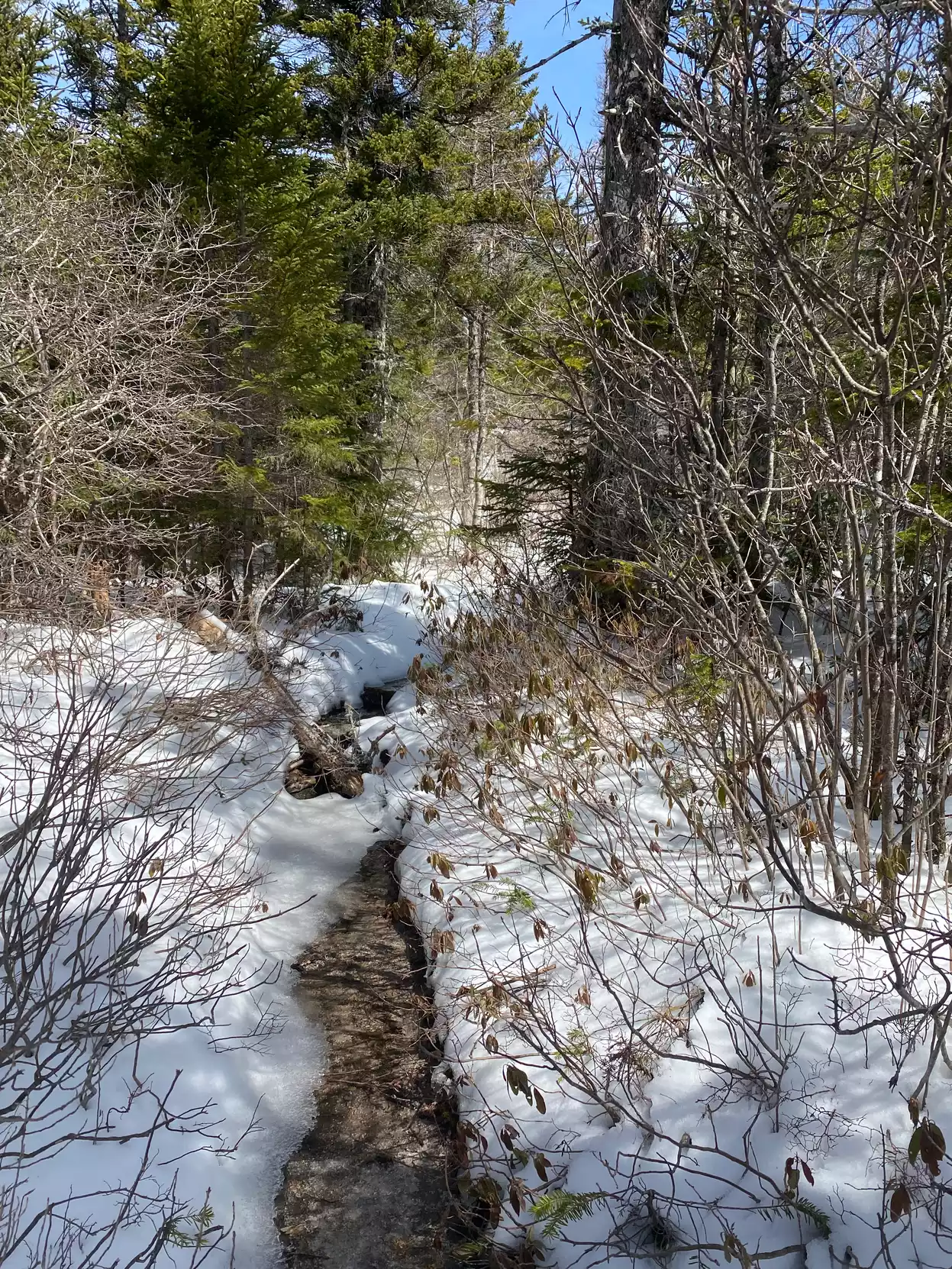

As daylight stretches a little longer and the temperatures rise, the White Mountains begin to shed their winter coat of snow and ice, allowing the dormant landscape below to bloom. Songbirds, vibrant flowers, and the smell of sun-warmed damp soil fill the senses of winter-weary hikers looking for ways to enjoy the splendors of spring after a season cooped up indoors.
Every year, the White Mountains–and other public spaces across the northeast–see an influx of users during the spring. And with good reason–spring hiking offers fewer crowds at popular trails and the rejuvenating sights and sounds of a forest coming back to life. So, if spending time in nature is part of your spring plans, there are some things you will want to know to get the most out of your hike.
If you’re new to hiking in the White Mountains, you may not have heard about the northeast’s “mud season.” It resides between winter snowmelt and spring rain, and–true to its name–often makes hiking a little messy. As a result, mud season can discourage some hikers from taking to the trails. But the team at Guineafowl Adventure embraces mud season as a way to reconnect to our inner child while in the forest.
The National Forest Service encourages hikers not to widen trails by attempting to avoid the mud, as this can damage fragile ecosystems. It’s part of the Leave No Trace principles, and it permits fun-loving hikers to play in the mud. A messy hike can be fun, so check out our gear section to help you prepare to get a little muddy and wet on a spring hike.
If spring precipitation isn’t making mud, it’s filling riverbeds and seasonal creeks. Snowmelt and spring rains transform small streams into swift rivers. If your route has seasonal wet areas or known water crossings, plan to get your feet wet. Most waterways will remain safe, but hikers will greet them with frigid water temperatures. However, knee-deep water and swift-moving currents can be dangerous–if a waterway isn’t safely passable, plan to turn around.
Hikers may encounter monorails on high-elevation hikes–perhaps those looking to peak-bag some 4,000-footers. A monorail is the compacted and still-frozen narrow strip of ice and snow in the center of a trail. Like mud puddles on a trail, monorails are the best place to hike on a trail. Practice your balance and save the foliage by sticking to the middle of the trail–even when it’s a snowy or icy monorail.
When hiking to a higher elevation in the spring, it’s important to remember that the weather changes as you climb. For example, it may be a warm spring day in the trailhead parking lot, but 2,000 to 3,000 feet higher, winter conditions may linger into June. So don’t be fooled by lower elevation conditions–check and double-check the weather for higher elevations before you begin your hike.



Spring in the mountains doesn't always look like Spring at lower elevations. The photos above are from founder Dave Fatula's late April hike on Mt Crawford. Center, Dave points to a peak in the distance–Mt Washington (also seen in the photo on the left). Right, spring snowmelt leads to an opportunity for splashing around mid-hike.
Good hiking boots are always an essential item, but spring hikes that include a lot of moisture may also necessitate waterproof boots designed to handle mud and water crossings. Footwear with grippy tread will help hikers navigate wet rocks and roots, while a waterproof lining will keep your feet safe from small puddles. If moisture can infiltrate the boot from above, you may want to wear gaiters to keep snow from entering the ankle or carry water shoes to slip on when crossing a waterway. If going above treeline, it's a safe idea to carry a pair of microspikes, and sometimes even crampons and snowshoes, depending on where and how high you’re planning to trek. Again, all of this extra gear may not be necessary, but be sure to check trail conditions and weather as late as the morning of your hike to make sure you know what you need.
Similar to muddy trails turning into snow or ice as you climb, a 60-degree spring day at the trailhead doesn’t mean the hike's summit will be as warm and sunny. Expect the temperature to drop at least a few degrees every 1,000 feet of elevation gain on a good day, not to mention how strengthening wind conditions above the treeline can impact your comfort. A merino wool base layer will keep early hike sweat from lingering at higher elevations and causing a cooling effect. On top of that, a waterproof shell is a good, lightweight layer that stuffs in your pack when you don’t need it and can be called on if the temperature drops or you encounter snow or rain.
Pre-planning and knowing local trail conditions are essential parts of creating a fun and safe spring hike in the White Mountains. Because of winter conditions at higher elevations in the spring, choosing hikes at lower elevations and on south-facing slopes helps protect fragile ecosystems and may create a more enjoyable hiking experience. At Guineafowl, our favorite beginner spring hikes are Mt. Crosby and the Welch-Dickey loop.
Mt. Crosby––This lesser-known hike in the Lakes region of the White Mountains offers a variety of terrain through meadows, forests, and finally granite above the treeline. Guineafowl's preferred loop has mostly gradual inclines with only a few steep pitches and multiple view corridors from the top. This is a nice hike that doesn’t get too crowded, a selling point for us.
Distance: 4.90 miles
Elevation Gain: 1,463 ft
Hike Score: 120
Welch & Dickey Mt. Trail––The first time Guineafowl founder, Dave Fatula, hiked this loop with his daughter, she couldn’t believe we were going back up a second peak – she said, “you didn’t tell me we had to climb two mountains!” Dave replied, “why do you think it has two names?” As you guessed by now, Welch-Dickey is a two summit loop trail with gradual climbs, incredible views, and a very gentle easy descent back down to the parking area, perfect for the first of the season hiking adventure.
Distance: 4.70 miles
Elevation Gain: 1,824 ft
Hike Score: 131
Guineafowl Adventure Company provides full-service, turnkey guided day hikes in the White Mountains and beyond for people of all abilities and experience levels. We take care of all the planning and preparation for hiking and provide round-trip transportation from the Greater Boston area, day packs with hydration and snacks, safety and convenience items, and friendly, knowledgeable, and experienced guides to lead the way!
Guineafowl's mission is to remove the barriers and obstacles that keep people from exploring nature, so they can feel comfortable, safe, and relaxed while experiencing the physical and mental health benefits of hiking and connecting with nature.
Visit our website to schedule your guided hike or contact us to book a private excursion.